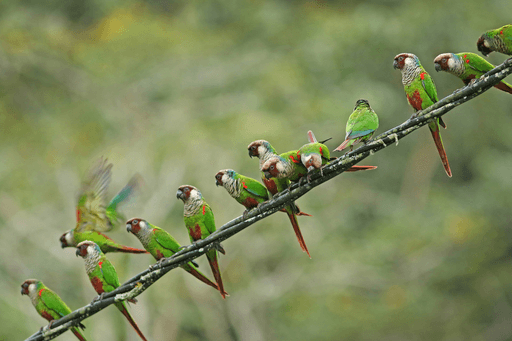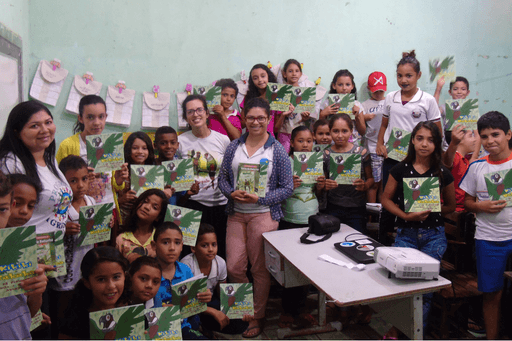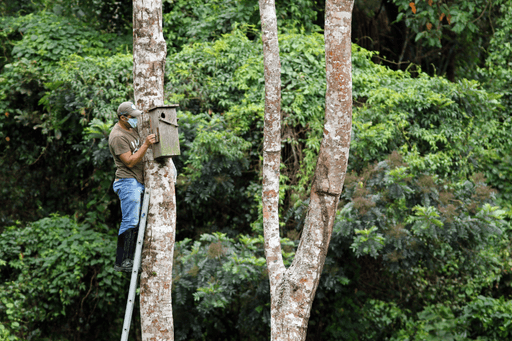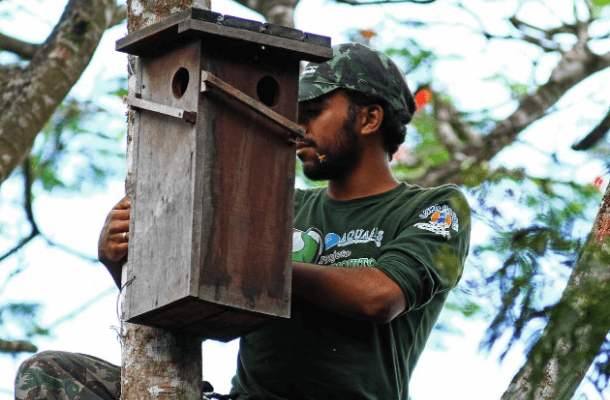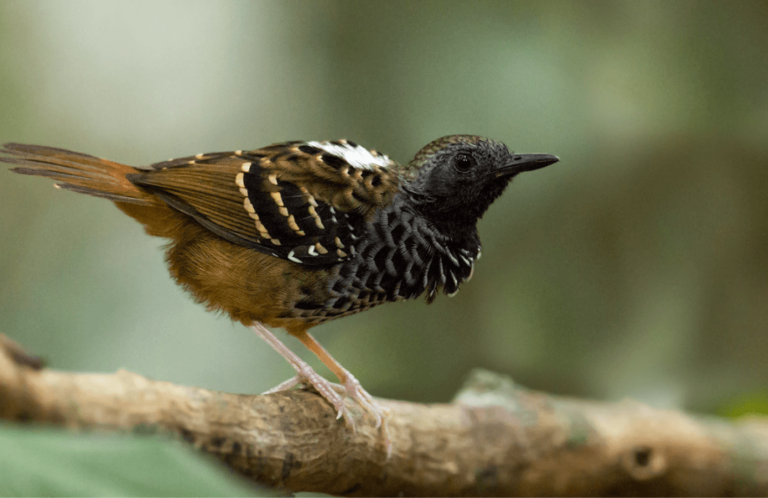Gray-breasted Parakeets, Once Nearly Extinct, Fly Free at Reintroduction Site
Last month, three wild-hatched Gray-breasted Parakeets took flight in a private reserve in the Aratanha Mountains in Brazil — likely the first fledglings of this species in this location in decades. This milestone seemed impossible just over a decade ago, when the species was confined to a couple of small, isolated forest fragments and on the cusp of extinction in the wild. Now, however, Gray-breasted Parakeet recovery is a shining example of what conservationists can achieve in a relatively short amount of time with the right resources and community support.
A Bird on the Brink
Gray-breasted Parakeets are small, social parrots with green bodies, white cheeks, and bright red tailfeathers. The birds were once widely distributed across the humid mountain forests of eastern Brazil, flitting through the canopies and distributing seeds as they foraged for food in tight-knit family groups.
Beginning in the late 1800s, deforestation and the European pet trade forced the canopy-loving birds into areas with the least human disturbance — isolated fragments of high elevation forests on mountaintops. Over the course of the 20th century, the isolated subpopulations blinked out, until just one viable population estimated at less than 100 individuals remained, in the Baturité Mountains. By 2007, the species was listed by the IUCN Red List as Critically Endangered — in imminent risk of extinction.
In 2009, Brazilian conservation organization Aquasis began working in the Baturité Mountains to save this last group of birds from extinction. Aquasis hoped to not only save Gray-breasted Parakeets from extinction, but recover the population to such an extent that the species could be reintroduced across its historic range.
At the time, this hope seemed far-fetched. For one thing, even in the Baturité Mountains' relatively intact forest habitat, there were not enough of the big trees with hollow cavities that Gray-breasted Parakeets need for their nests. Most of these had been cut for timber, leaving behind only the smaller trees in the forest. On top of that, parrot poaching was still a significant problem in the region. But Aquasis devised a plan to address both of these threats.
Making Gray-breasted Parakeets Feel at Home
The first part of the plan, launched in 2009, was to build artificial nest boxes big enough to fit the gregarious parrots' family units of seven or more birds. These could stand in for the tree cavities the birds need to reproduce, and also give biologists a way to easily monitor the struggling species.
The plan was a good one, but it got off to a rocky start. “They put up ten boxes, and like seven of them had bees in them,” said Bennett Hennessey, Brazil Conservation Program Coordinator for American Bird Conservancy (ABC), who visited the site that first year.
Little by little, Aquasis refined their approach, and once the parakeets began to use the boxes, the bees steered clear of the new real estate. Two years after the nest box program launched, 33 chicks fledged. By 2017, hundreds of chicks had fledged from nest boxes placed by Aquasis with the support of Loro Parque Foundation — enough to get the species downlisted from Critically Endangered to Endangered. Now, when the organization puts up new boxes in the area, the parakeets find them independently and start using them almost immediately.
In 2022 alone, 472 chicks fledged from 150 nest boxes, bringing the total to nearly 2,500 Gray-breasted Parakeet fledglings resulting from the nest box program.
After the nest boxes began producing results, Aquasis launched an education campaign to tackle the poaching issue, with support from ABC. The campaign encouraged a sense of pride among the local community about their feathered neighbors.
This, too, was a remarkable success. Poaching is not nearly as much of an issue anymore, and in 2018, the government of the Brazilian state of Ceará gifted land to be used for Gray-breasted Parakeet conservation thanks to these relationship-building efforts.
“The education campaign is an important reminder that buying land is not the only thing that's productive for conservation,” Hennessey said.
With the population ballooning to more than 1,000 birds in ten years, it was time to begin phase two of the plan: capturing birds in the Baturité Mountains and reintroducing them to new sites.
A Successful Experiment

Aquasis found five sites that would be a good fit for the reintroduction of the species, providing the dense canopies with rich supplies of fruit and seeds that the birds need to thrive. For the first attempted reintroduction, they selected a protected area in the Aratanha Mountains, about 35 miles northeast of the Baturité Mountains.
With support from ABC, a team built an aviary there that could serve as a sort of acclimation area for the relocated birds, where biologists could provide them with food and shelter as they got used to the new environment. Then it was time to get the birds.
In November 2021, conservationists carefully moved 14 Gray-breasted Parakeets comprising two family units to the new site. The parakeets acclimated quickly, readily eating the feast of fruits and seeds laid out for them each day. In May 2022, four months later, the team decided that it was time to open the doors of the aviary.
While everything had gone smoothly so far, there was no guarantee that this part would work. Reintroduced parrots are notorious for simply flying off into the distance, never to be seen again, according to Hennessey. “This was a big test to see if we could actually do this,” he said.
In the case of the Gray-breasted Parakeets, the team was hopeful that nest boxes put up near the aviary, and fruit left out at the site, would encourage them to stick around. But when they opened the gates, the whole flock instantly flew away.
The team waited, straining their ears for the telltale squeaky calls of the gregarious birds. After a tense hour, the parakeets returned to eat from the feeders in the open aviary. Everyone breathed a sigh of relief. That night, the parakeets roosted in the nest boxes that the team had placed around the site.
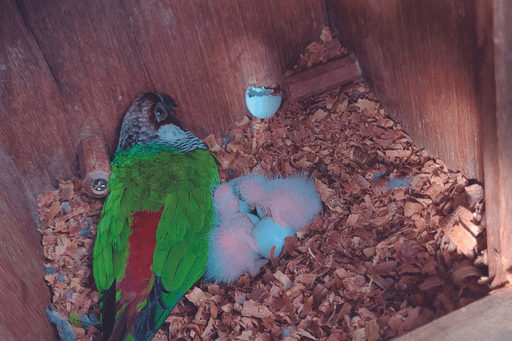
Aquasis brought two more groups of parakeets to the Aratanha Mountains over the next several months, both of which acclimated quickly and joined the other birds in the canopy. By late last year, some of the parakeets were comfortable enough to begin laying eggs in the nest boxes. This February, the first batch of chicks fledged.
"This is possibly the first planned translocation of an endangered species in Brazil, and we are happy to be part of this story,” said Fabio Nunes, Gray-breasted Parakeet Project Coordinator for Aquasis. “For the Gray-breasted Parakeet, it is one more step away from extinction."
Hope for the Tropical Birds of the Americas
This reintroduction success is proof that species can be brought back from the brink if conservationists have the right tools and support. Gray-breasted Parakeets, once on the cusp of going the way of the Dodo, are now helping to restore biodiversity to forest fragments throughout northeastern Brazil, and could even serve as a model for other reintroduction efforts.
“These forest habitats are adapted to having these parakeets in them, and we really want to try to recuperate the ecology of these fragments as much as we can,” Hennessey said. “The dream would be that every nice, fertile forest in the northeastern states would have Gray-breasted Parakeets again.”
###
American Bird Conservancy is a nonprofit organization dedicated to conserving wild birds and their habitats throughout the Americas. With an emphasis on achieving results and working in partnership, we take on the greatest problems facing birds today, innovating and building on rapid advancements in science to halt extinctions, protect habitats, eliminate threats, and build capacity for bird conservation. Find us on abcbirds.org, Facebook, Instagram, and Twitter (@ABCbirds).
Media Contact
Jordan Rutter
Director of Communications
media@abcbirds.org





































